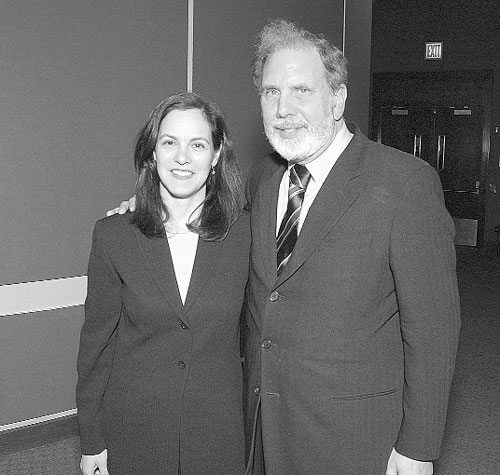By Lincoln Anderson
N.Y.U. President John Sexton and Sharon Greenberger, N.Y.U.’s new director of campus planning and real estate.
With the hiring of Sharon Greenberger as its inaugural director of real estate and campus planning, New York University says it is taking a fresh approach to the use of its existing facilities and development of new ones.
Greenberger has extensive experience in planning and development. She most recently served as chief of staff to Dan Doctoroff, deputy mayor for economic development and rebuilding, in which capacity she managed the city’s economic and planning agencies and developed citywide policies and programs. From 1998-2001, she was a vice president at the Downtown Alliance business improvement district, where she created and implemented economic development and residential strategies for Lower Manhattan.
Greenberger was hired by the university 10 months ago and has been put in charge of overseeing all its real estate and acquisitions, planning, design, construction, space usage and maintenance. Most significant, N.Y.U. officials say, under Greenberger a clear separation has been made between planning and construction divisions.
N.Y.U. plans to start a long-term strategic planning process early next year, which, Greenberger said, will focus on defining the long-term aspirations and goals of the university. However, N.Y.U. can’t give more details about what this long-term plan may entail at this moment, as the process hasn’t started yet, Greenberger said in an introductory interview last week.
Planning will have to take into consideration the university’s current push to increase the number of faculty for its undergraduate College of Arts and Science by 125, which will create a need for more faculty housing and for senior faculty offices.
However, it’s obviously the university’s huge student population that has the biggest housing requirement. From a relatively small commuter school of 8,800 undergraduate students in the early 1970s, the university’s enrollment has more than doubled, currently with 18,000 undergraduates. About 11,000 undergraduate and 1,000 graduate students live in university housing. According to Lynne Brown, N.Y.U. senior vice president, who also participated in the interview, the university has no desire to grow its student body.
Brown said that undergraduates living in leased housing in Lower Manhattan — such as N.Y.U.’s 200 Water St. residence, which has about 1,200 students — have been complaining that they want to be closer to campus. So now the university’s goal is to try to concentrate the students more in a cluster, one of which exists around the nexus of Third Ave. and E. 14th St., where N.Y.U. already houses about 4,000 students in existing dormitories. Housing students in this area “makes sense,” according to N.Y.U.
N.Y.U.’s deal to lease, and possibly buy after one year, a 26-story dorm that Hudson Companies is building for it on E. 12th St. is part of this new plan to house students in a cluster closer to campus.
However, a few years ago, when community anger reached a peak over N.Y.U.’s building of its new Kimmel Student Center and School of Law buildings on Washington Square South, the university’s line was that it would try to relocate students to “the perimeter” of the Village and at residences farther away, such as Water St.
About 3,000 N.Y.U. students are housed south of Houston St., Brown said. The university isn’t exactly sure how many of these students it would want to move north into the Village and Union Square area, Brown and Greenberger said. Up until now, students have been assigned to housing on a lottery basis, but from now on will have more choice on where they live. So some students might conceivably prefer to live farther Downtown, Brown pointed out.
Although the leases are expensive, Brown and Greenberger said N.Y.U. would like to maintain some leased housing to insure its real estate portfolio is diversified, in case, for example, the housing market has a downturn. The school is currently trying to renegotiate a long-term lease for the Water St. residence, a converted office building.
Neither Brown nor Greenberger was enthusiastic about the suggestion being voiced by some that N.Y.U. set up a satellite campus for students.
Meanwhile, Greenberger said, things are a bit more flexible where faculty are concerned. N.Y.U. currently owns 2,400 faculty and residential apartments. The university might try to find housing opportunities for some faculty in New Jersey, for example, which could free up housing for students around Washington Square.
Part of Greenberger’s job will be figuring out how best to reuse N.Y.U.’s existing space. One current project in this vein is at 12-16 Waverly Pl., where the university will gut rehab several loft buildings for use as a life sciences and genomic research facility.
In other matters concerning the university’s physical plant, N.Y.U. is working to make its buildings around the east side of Washington Square more esthetically attractive and connected to the community at street level by opening up their exteriors by installing large glass windows; classrooms are being brought down from higher floors to ground level. This has been done on W. Fourth and Mercer Sts. at the former Bottom Line music club space, which N.Y.U. has converted into classroom space. Brown said this use of glass is a sign of N.Y.U.’s improving its design sensibilities.
They reiterated Brown’s statement of a few weeks ago to The Villager that N.Y.U. currently has no plans to speak of for one of its primary development sites, its property with the Morton Williams supermarket at Bleecker St. and LaGuardia Pl.
google_ad_client = “pub-5121976262849259”;
google_ad_width = 728;
google_ad_height = 90;
google_ad_format = “728x90_as”;
google_ad_type = “text_image”;
google_ad_channel =””;
//–>
WWW Downtown Express


















